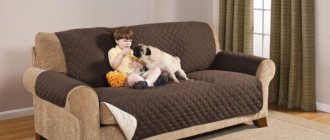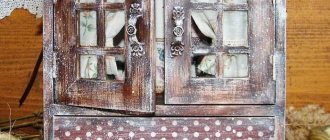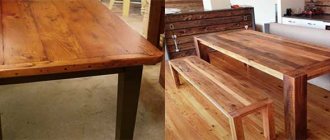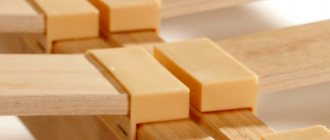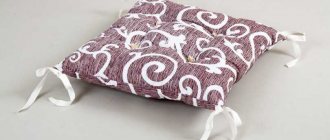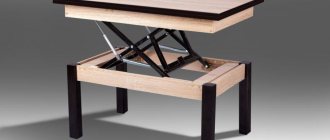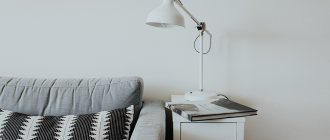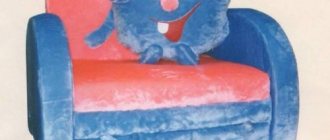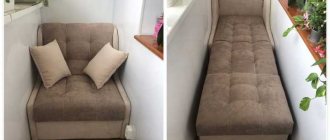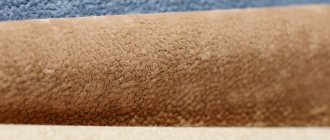There is no need to think that making a sofa for the kitchen is a complex technological process. If you take into account all the rules and follow the recommendations, you can create a solid, high-quality design. And the stage of finishing a piece of furniture will be the final fireworks.
In this article we will try to figure out how to properly make a sofa with your own hands.
A sofa is a necessary thing in everyday life. There are many variations of a piece of furniture. Due to the fact that it allows long-term, repeated use, the wear threshold increases sharply.
For this reason, sofas are in great demand.
The main positive side of installing a sofa with your own hands is the opportunity not to overpay in the store for something that costs much less than a “designer” one.
So, having purchased the necessary materials and prepared construction utensils, you can make a corner sofa in a home workshop in a matter of hours.
Factories produce monotonous models. If you make furniture with your own hands, you can make it of the type and design that you have outlined in your fantasies. This is another advantage of creating the design yourself. The variety of construction department stores and supermarkets determines the availability of any of the materials.
Thanks to this, the choice of lumber, fasteners, and finishing elements for the future product has expanded.
Deciding on design and construction
The most popular, practical option is the kitchen corner sofa. This design can be used by disassembling into separate sectors or placed in one piece, along the perimeter of the wall.
In addition, the models are appropriate in the kitchen interior and practical in everyday life.
So, by covering the wooden panels of the sofa with varnish, you can protect it from the influence of humidity, dampness, and excessive dry air. A corner installation, consisting of two benches with a rounded middle, will take up a small space in the kitchen, which is very convenient.
The aesthetically attractive glossy finish makes it easier to remove greasy stains from the surface.
There are two types of corner sofa: stationary and sliding. The first one is easier to install, so it will perfectly “teach the hand” of a novice master. The sliding design is troublesome to implement, but outwardly it is quite presentable. By following the diagrams and recommendations, it is possible to make both types with your own hands the first time.
Since most dining tables are wooden, the base and handrails of the corner should be made of a similar material.
When designing the kitchen sofa of your dreams, you need to decide on the upholstery. It is this detail that will create an original, interesting piece of furniture. The choice of cushioning material can be microfiber or artificial leather. To make the sofa seats as soft as possible, it is important to choose the filling wisely. There are materials of normal, increased rigidity, soft, hard, elastic. All types will provide additional comfort and softness.
You should choose the filler based on your preferences.
What to consider when choosing materials
The choice of a kitchen corner should be approached responsibly, because this piece of furniture is made to last for many years, and how comfortable and enjoyable breakfast, lunch, and evening tea drinking will depend on its appearance and convenience. In addition, making furniture yourself means feeling like a designer and acquiring a source of pride.
As for upholstery, it is better to prefer synthetic materials, leatherette, because they are more practical: they retain their appearance much longer and are easy to clean. The material must have dirt-repellent properties, be moisture-resistant, and withstand regular cleaning. The upholstery must be durable and able to withstand the weight of people sitting on it.
- Microfiber. This fabric is durable, stain-resistant, and has a non-fading color. If there is a Teflon coating, then drops of water are not absorbed, but roll off along the surface.
- Velours. It is not recommended to choose velor as upholstery for kitchen upholstered furniture due to its impracticality. Although the cost of the material is low, food particles and liquids easily eat into the structure, and frequent washing and cleaning renders it unusable.
- Flock. This material is an excellent choice for pet owners. Not only does no hair remain on it, but claw marks are almost invisible. Flock is a durable, practical option for upholstery and does not require serious maintenance.
- Faux leather. Resistant to temperature changes, suitable for frequent washing with detergents, does not fade.
- Genuine Leather. The high cost of the material is compensated by its durability, but leather care is not the most practical. It should not be rubbed, because the area where it was cleaned may change color or become deformed.
Before you start work, you need to prepare all the necessary tools and materials that will be required to make the sofa. For the frame, you can choose laminated chipboard; it has a number of advantages: affordable price, wide selection of shades, and resistance to high humidity.
Foam rubber or polyurethane foam is used to fill the backs and seats. To avoid deformation, the material must be sufficiently rigid.
The width of the seats should not exceed 40-45 cm, and the legs of the sofa should be under the vertical profile of the seat, otherwise there will be inconvenience when sitting at the dining table.
Necessary materials
The choice of manufacturing materials is an important step, since the durability of the structure and reliability depend on their quality. When buying lumber, you need to take a slightly larger quantity. This causes the presence of defective elements.
For the kitchen structure you will need:
- Bars 15*15 mm – 1.2 m;
- Bars with a cross section of 40*40 mm – 0.135 m;
- Bars 25*25 mm – 3.6 m;
- Bars 30*30 mm – 1.2 m;
- Board with a section of 20*350 – 1 m;
- Rail 20*60 mm – 2.1 m;
- Plywood 1.2*45*255 cm;
- Foam rubber;
- Plugs for fastening;
- Piano hinges;
- Angles;
- Euro bolts;
- Wood glue.
- Chipboard.
Materials for making a corner sofa.
Various types of fastenings.
Before starting the main work, it is important to decide on the size of the sofa. Craftsmen do not recommend performing it according to standard parameters, since the slightest deviation from the norm can ruin the design.
Dimensional plan of the kitchen sofa:
- Main sofa: length 1.2 m, height 0.85 m, back height 0.3 m;
- Side sofa – 0.45*0.45 m;
- The width of the side panels is 0.45 m;
- Seat height – 0.4 m.
These figures are conditional, but experts recommend not deviating from the parameters, otherwise the risk of production defects will increase.
DIY soft kitchen sofa with sleeping area
As one of the options for making a kitchen sofa with a forward folding mechanism, Meralat. For production you will need ordinary furniture materials and tools. We replace all missing elements with analogues if necessary.
We use 15 mm plywood. Optional 20 mm. If we consider a cheap, inexpensive option, then we take chipboard, preferably at least 18 mm. But in the end it can affect the life and quality of the product.
We assemble the frame from plywood and wooden beams using wood screws.
We cover it with foam rubber and padding polyester. We insert the folding mechanism of the required width of the berth.
This is what the sofa will look like when unfolded.
The mattress is sold together with the mechanism, but it will be cheaper to do it yourself. We select the density of foam rubber according to the desired softness and service life.
Covered with fabric. In this case, velor was used. For simplicity, you can make joints in some places, and not with a solid cover, as in the photo.
We cover the seat cushions with padding polyester. Blue and white foam rubber of different densities are used for seating.
Let's try on what it will look like in height and width. We choose the best option for ourselves. The standard seat height is 45 cm.
We cover the mattress with fabric. This is what the finished product looks like when unfolded. The mechanism used is 100 cm wide. The overall width of the sofa is about 125 cm.
Required Tools
In the event that the kitchen corner will be made with your own hands, you need to take a set of tools from the carpentry shop:
- Wood file;
- Drill;
- Electric jigsaw;
- Screwdriver;
- Electronic planer;
- Building level;
- Ribbon;
- Sandpaper;
- Scissors;
- Stapler with staples.
- Knife for foam rubber.
This is the main list. Be sure to prepare safety glasses, gloves, a simple pencil for marking, and a ruler.
Design of the finished model
If you were able to make a kitchen sofa with your own hands, then you can definitely handle its upholstery. To do this, you may only need a construction stapler and staples, and you can also prepare a project or drawing in advance that could bring your plans into reality and prevent you from missing some important details. The main thing is not to waste foam rubber on the sofa you have made. This material makes the furniture most suitable for use, and since we all spend a lot of time in the kitchen, a comfortable place to relax is a must.
Remember that the furniture is made for the kitchen and therefore the upholstery fabric should be chosen that will not be difficult to clean later. Various prints and decorative elements will help make it brighter, as well as place the sofa correctly in the kitchen. In addition, in order to keep it clean, you can use original covers or capes.
When wondering how to make a beautiful sofa for the kitchen with your own hands, answer yourself that everything is quite simple and possible. The main thing is to believe in yourself and follow the prepared drawings and diagrams. Remember that by making furniture yourself, you will significantly save your family budget. In addition, as a result, you will receive not just the same type and standard store model, but an individually executed project that no one else has.
Having acquired this knowledge and skills, you can not stop there, but conquer new heights in making furniture yourself. Sofas are needed always and everywhere, and original sofas are generally quite difficult to find; making one yourself is much easier.
Assembling a sofa for the kitchen
Construction of the structure body is 50% of the implemented idea. To form a sofa you need to make seats. You need to make “skeletons” from a 25*25 mm bar. They are sewn up with plywood sheets 25 mm thick. Unevenness and joints are rubbed with sandpaper. A prerequisite is the treatment of wood elements with an antiseptic solution, a layer of stain, and varnish.
Foam rubber is attached to the front side of the lid with a stapler or lowered with glue.
Piano hinges should be strengthened along each one. Afterwards they will connect the main module with the seat. Before upholstery, all open areas of the modules are covered with plywood, and the seats are attached to the frame. The wood is covered with varnish color.
Place to rest
Nowadays, the kitchen has become not only a place where people eat or prepare food. This is a place where family and friends gather around the same table to have a pleasant conversation and share secrets in a cozy atmosphere. Therefore, the kitchen becomes one of those places in the house where it is necessary to organize a comfortable place to relax.
Purchasing a narrow sofa or couch that is small in length and centimeters will make the room more than just a kitchen. This will become a place where guests can sit comfortably and talk over a cup of tea, a place where they can always lie down and relax. In addition, if necessary, such a couch can become an additional sleeping place. The daybed can be foldable and can have built-in storage drawers, allowing you to free up some space in your home. This seating area will be a good addition to your kitchen.
Couch
A couch in the kitchen doesn’t have to mean an uncomfortable slipper.
Daybeds are a great addition to the kitchen. Such furniture elements combine convenience and compactness. Not only does a daybed create a place to relax in the kitchen, but it also provides extra seating at the table and is a great decorating idea.
Such couches resemble a small but comfortable sofa. Depending on the design style of your kitchen, you can purchase both wooden and plastic couches. The seat material will be soft one way or another. When choosing such furniture, be sure to take a closer look at the upholstery. Upholstery made of leather or leatherette is best suited. This material is easy to clean, unlike expensive upholstery. After all, in the kitchen the product is always at risk of getting dirty.
When furnishing small dining rooms in Khrushchev, you can purchase a comfortable corner couch. Located along the walls, the product will not take up a large amount of space and will replace a sofa bed.
Kinds
Kitchen couches come in a wide variety of types. First of all, it is worth noting their classification by size. They come in large, medium and small. Therefore, depending on the dimensions of your kitchen, you can choose a suitable product. Another classification divides couches into straight and corner. Straight daybeds are more suitable for wider spaces. As for corner couches, they are more compact and designed for a smaller space. In the corner of the product there is a convenient shelf suitable for a plant or napkin holder. In addition, such couches are equipped with internal drawers for storing vegetables, which is also convenient for the kitchen. Straight ones can serve as a sleeping place, unlike corner ones.
A broader classification of the types of couches divides them into:
- couches with/without armrest;
- with/without back;
- on thin/thick legs;
- soft type couches (fully upholstered in fabric) / couches with a metal frame;
- leather couches;
- couches with drawers.
For small kitchens, folding couches are an excellent solution. During the day they will be used as a place for gatherings, and at night they can be transformed into a sleeping place.
This small product will perfectly complement the interior of your kitchen and will delight you with its functionality and low cost.
Upholstery materials
Choosing the best upholstery materials is one of the main tasks when buying a couch.
The material must be reliable, cleanable and easy to care for.
Among the most common materials you will find:
- synthetic;
- mixed;
- microfiber;
- original materials (leather, ivy, velor).
Synthetic upholstery is the most practical. It will not lose its shape and color even after a lot of cleaning. However, such fabrics are highly electrified and attract large amounts of dust.
Blended materials may include a mixture of wool or cotton with synthetics. The downside of this upholstery is that it is susceptible to fading over time. This is due to the fact that the dye adheres worse to the mixed type of material due to the different structure of the fibers.
Microfiber is a mixture of polyester and cotton coated with Teflon. This is a fairly popular material because it is easy to clean, does not fade or wear out.
When choosing unusual upholstery, such as leather or velor, pay attention to the color and texture. It is important that the upholstery looks cozy and fits into the overall interior. Such materials are also wear-resistant and easy to maintain.
Kitchen sofa upholstery
The DIY kitchen sofa is almost ready. The next stage is upholstery. The material chosen is synthetic winterizer or foam rubber. Each element of the sofa is measured.
The upholstery material is cut out according to the parameters, attached directly to the furniture parts with glue.
We do the back upholstery in the same way.
Next, you should cover the lining with fabric. In this regard, the most used fabrics are jacquard, velor, microfiber, flock. To perform processing, cut out parts of the selected material according to the dimensions of the sofa elements with allowances.
The material should be attached to the backs of the modules and the joints with the seats.
The final stage of making a corner sofa with your own hands is assembling all the parts into one whole.
About the restoration and types of repairs of kitchen corners
You can choose a new corner to suit every taste. But frequent use in a room with high humidity and frequent temperature changes harms the furniture. Over time, food and liquids inevitably leave stains on the upholstery, and the fabric can fray and tear. And now, a few years later, we have before us a strong set, but one that has lost all its luster.
The way out of this sad situation will be to reupholster the kitchen corner with new upholstery. The work can be entrusted to specialists, but independent repairs are also quite accessible at home for those who are not afraid and know how to work with their hands.
There are many advantages to reupholstering a soft corner with your own hands. Little skill is needed for such work, because the design is simple and the materials are available. Carrying out all the work yourself will save significant money. All materials can be selected to suit your taste. This is a great opportunity to gain and strengthen useful skills.
Upholstered furniture has the main characteristics:
- coloring;
- design;
- size;
- configuration.
Several years of use wear down the surface of the soft corner, and the design becomes boring. In addition to simply reupholstering furniture, you often want to introduce some innovations into the interior. If you think about such changes in advance, you can easily make them a reality during the process of upholstery replacement.
Let's consider possible options for modernization at home:
- A fashionable option for finishing the back and seat in different colors. These can be contrasting shades or similar combinations. An extravagant combination of colored and plain is possible.
- Patchwork style upholstery. Different pieces of fabric are assembled into a geometric pattern of squares, triangles, stripes, or a chaotic pattern of shapeless shreds. The chaotic pattern is very beautiful, but requires serious sewing skills.
- Use of decorative elements such as buttons. This way you can emphasize the volume of the product and give it an original look.
- Changing the configuration of parts that are not subject to load. A job requiring some carpentry skills. Decorative parts are first cut out of plywood, then attached to the back and sides. The last stage is decorating.
- Adding armrests with soft, removable pads. Such a change will make the furniture more comfortable and bring something new to the decor. In addition, removable attachments are much easier to update than to do a full restoration of the sidewall.
Sofas in the kitchen interior – 50 photo ideas:
PreviousChoosing a children's sofa bed
Next
Choose a sofa bed from Ikea
Assembly of straight sofas
Some owners want to save as much as possible on making a kitchen corner from chipboard and therefore plan to mill the shaped parts themselves. In this case, they need to adhere to the following recommendations while performing this work:
- To mill parts, you will definitely need templates, which are best made from plywood. At the ends, chipboard, as a rule, has a porous structure, so during this operation the cutter bearing will jump over uneven surfaces. As a result, the line on the part will not be straight. If plywood is not available, the chipboard template can be attached to the end using several layers of paper tape.
- It is unacceptable to use a grinder for final alignment of the ends of shaped elements. This tool does not allow for perfect perpendicularity of the end plane to the surface of the part. Using a grinder, it is impossible to obtain a flat surface, without which it will not be possible to carefully secure the edge to the end of the part.
- The front panel of the drawer must be installed at an angle. This will create more comfortable conditions for a sitting person to use it. To do this, the lower part of the side posts should not be cut straight, but at an angle of 10°.
When choosing ABS tape for edge processing , keep in mind that it may already contain glue or be without it.
Clean tape is intended for milling on machines. In this case, the glue is supplied from a separate container. If, due to carelessness, you purchase this particular type of tape, then you will not be able to make a corner using it at home. Having completed the operation of milling the shaped elements and securing the tape at the ends, you can begin to apply markings and assemble the sofas. When you mark the holes on the surface of the side posts, keep in mind that the front panel of the drawer should extend 2 mm into the depth of the material. As a result, the center of the hole will be located 10 mm from the edge. It is imperative to secure the thrust bearings at the lower ends. Confirmations and dowels are used for the kitchen corner made of chipboard For connections that ensure structural rigidity, it is best to use metal screws. In other cases, it is recommended to use dowels. This solution can minimize the number of through holes. Dowels are the only fastening element used to connect the lower back support strip to the main structure.
They are also called composite. Such models are not so popular among buyers, because in a small kitchen their functionality is significantly limited. As a rule, such a sofa consists of several separate parts: one part looks like a standard straight sofa, then an additional rack for storing things, as well as a side part, which is a separate armchair and is a stylistic addition to the design.
To properly equip your kitchen, you need to think through all the details. One of the important nuances is compliance with correct zoning. Of course, the kitchen should have a work area in which all cooking processes will be carried out, and a dining or living area is also necessary. It should be equipped with a table and seating. A good option for the kitchen dining area would be a kitchen corner. Several people can sit on it at once, it looks stylish, saves space, including due to the presence of storage compartments.
Of course, modern stores offer a wide range of different models of such furniture, but you can also make a kitchen corner with your own hands. This is not a quick process. It will require some preparation, time and the necessary tools. This will be discussed in this article.
